How to build a freelance marketplace
The tech to build a freelance marketplace similar to Fiverr or Upwork is available to everyone. Here's how to turn your idea into a successful business.
You’ve got an idea to create a website similar to Upwork or Fiverr. While it may sound ambitious, it’s definitely not impossible.
The freelance economy is growing fast. More and more professionals are choosing the flexibility and freedom of independent work, and by 2027, 50.9% of the U.S. workforce—around 86.5 million people—will be freelancing.
While industry giants like Upwork, Guru, Fiverr, and Thumbtack dominate the scene, there’s still plenty of room for new players who can carve out a niche (more on this later in the article).
In this guide, we’ll walk you through every step of building a freelance marketplace from scratch. You will learn how to refine your idea, develop must-have features for your marketplace, and successfully launch and scale your platform.
A freelance marketplace is an online platform that connects skilled independent professionals (freelancers) with clients who need their services. A freelance marketplace acts as a virtual meeting point or intermediary for businesses and individuals hiring short-term or project-based work skills. The freelance platform manages the entire process from job posting to project completion and payment, ensuring both parties enjoy a smooth process.
The freelance marketplace industry is diverse. Each one focuses on solving various needs of their niches or regions. Here's an overview of some of the common freelance platforms.
Upwork is one of the largest and most versatile freelance marketplaces. It offers various job categories across numerous industries, from writing and design to programming and consulting. It's a go-to platform for freelancers and clients seeking a wide range of skills. According to DemandSage, Upwork currently has over 18 million skilled freelancers and 5 million clients in over 180 countries. Check out our guide to build a website like Upwork to learn more!
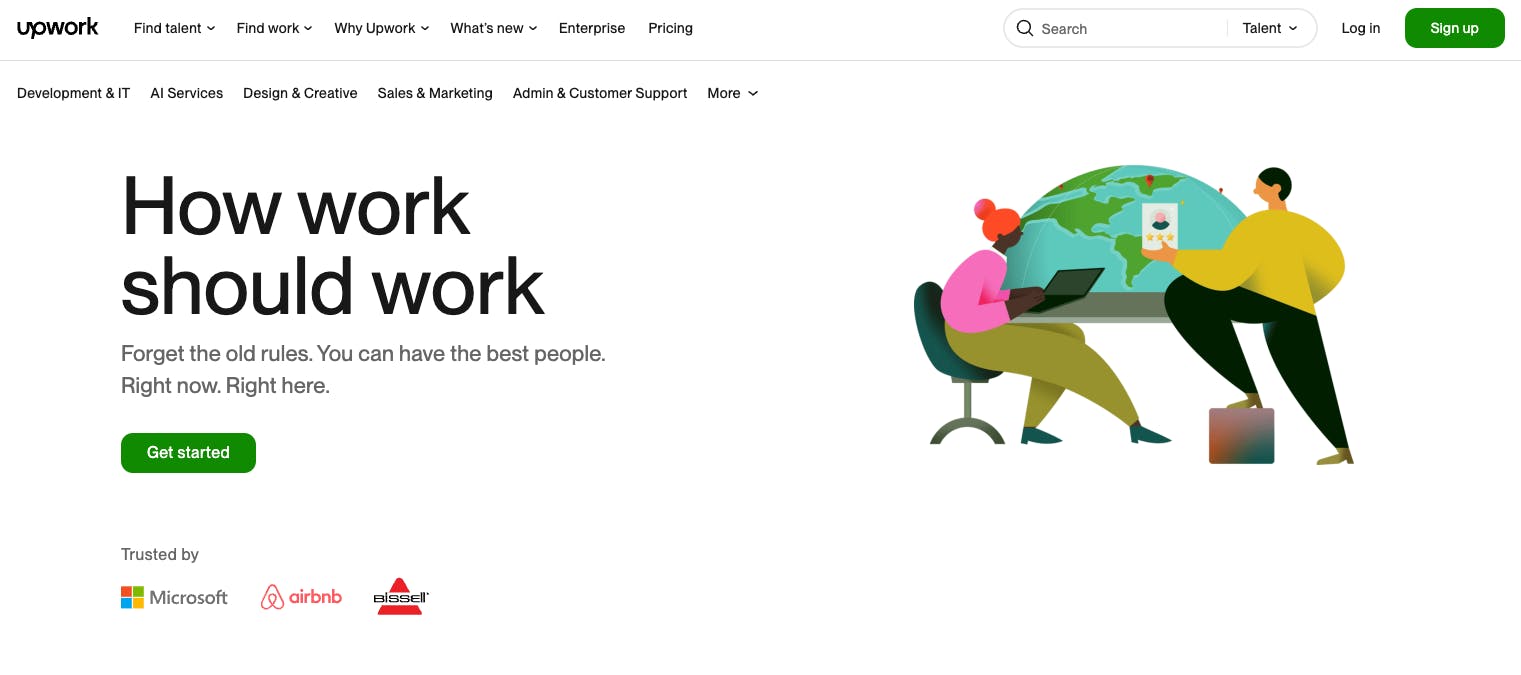
Fiverr is known for its innovative "gig" system, where freelancers can offer services starting at $5. Fiverr began with a focus on quick, low-cost tasks but has evolved to include high-value services across various categories. This makes it popular for both small tasks and larger projects. A Skillademia statistics report shows that the Fiverr Marketplace has 700+ service categories, 4.2 million clients, and over 380,000 active freelance sellers
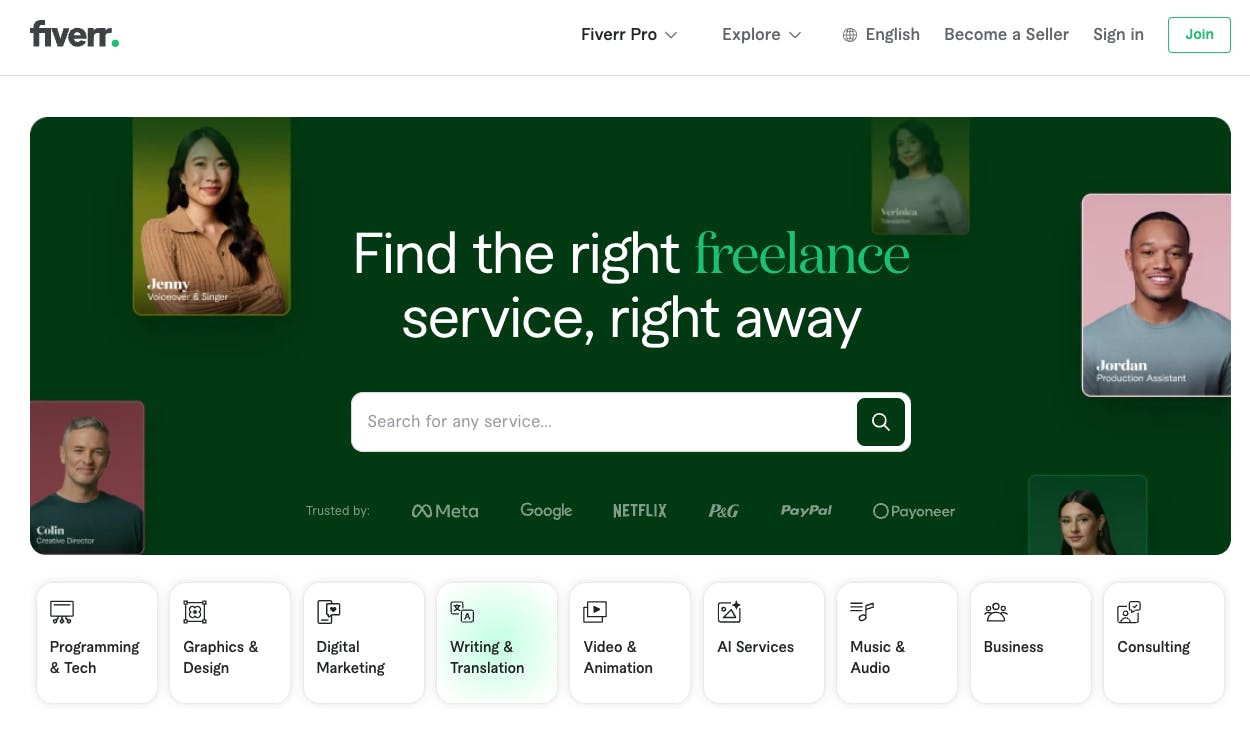
PeoplePerHour connects clients with freelancers for both hourly and project-based work covering categories like creative, technical, and professional services. The platform is particularly popular in Europe and is also known for pre-vetting its users to discourage fake accounts. There are over 3 million freelancers across 180 countries on PeoplePerHour.

Guru offers a secure, flexible platform for freelancers and clients to collaborate across fields like writing, tech, and finance. Its user-friendly interface features tools for easy project management and payment processing. Guru has over 2 million freelancers and 800,000 clients.
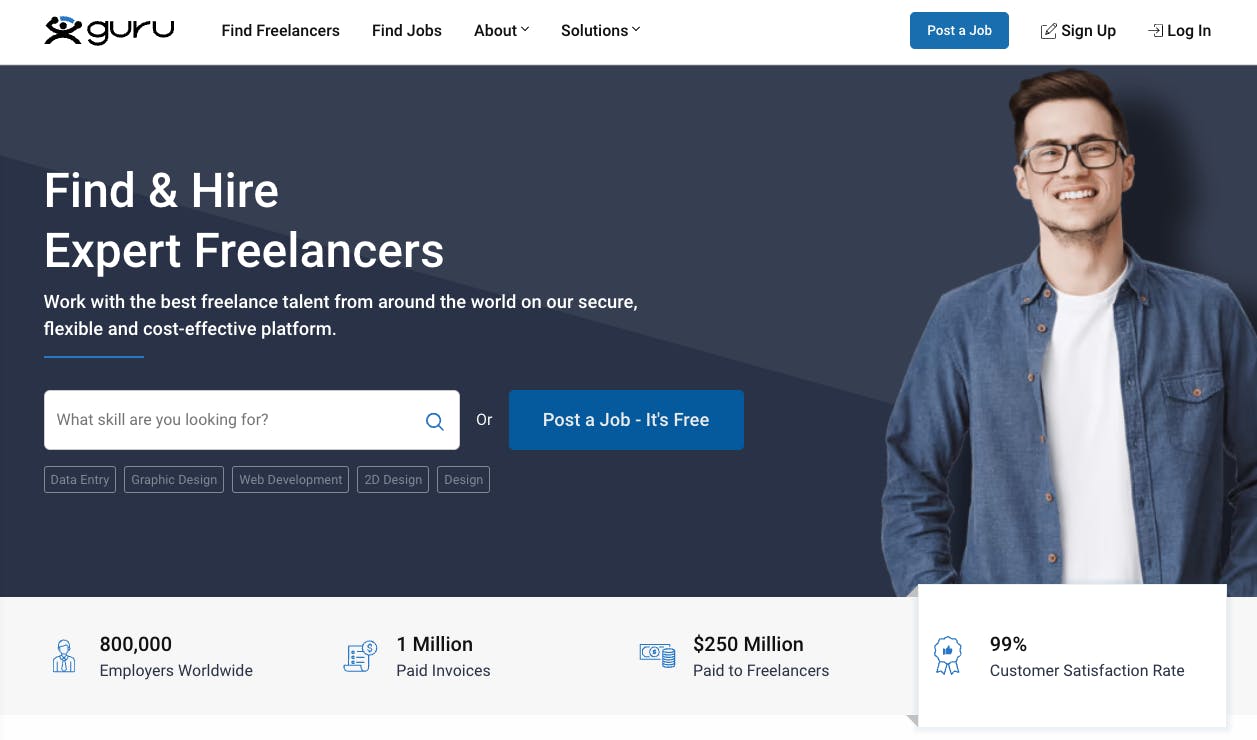
Freelancer offers over 1,800 job categories, including programming, web development, design, writing, data entry, and more. The platform uses a competitive bidding system where freelancers can pitch for projects. Freelancer is known for its global reach, with more than 76 million employers and freelancers from over 247 countries, regions, and territories.
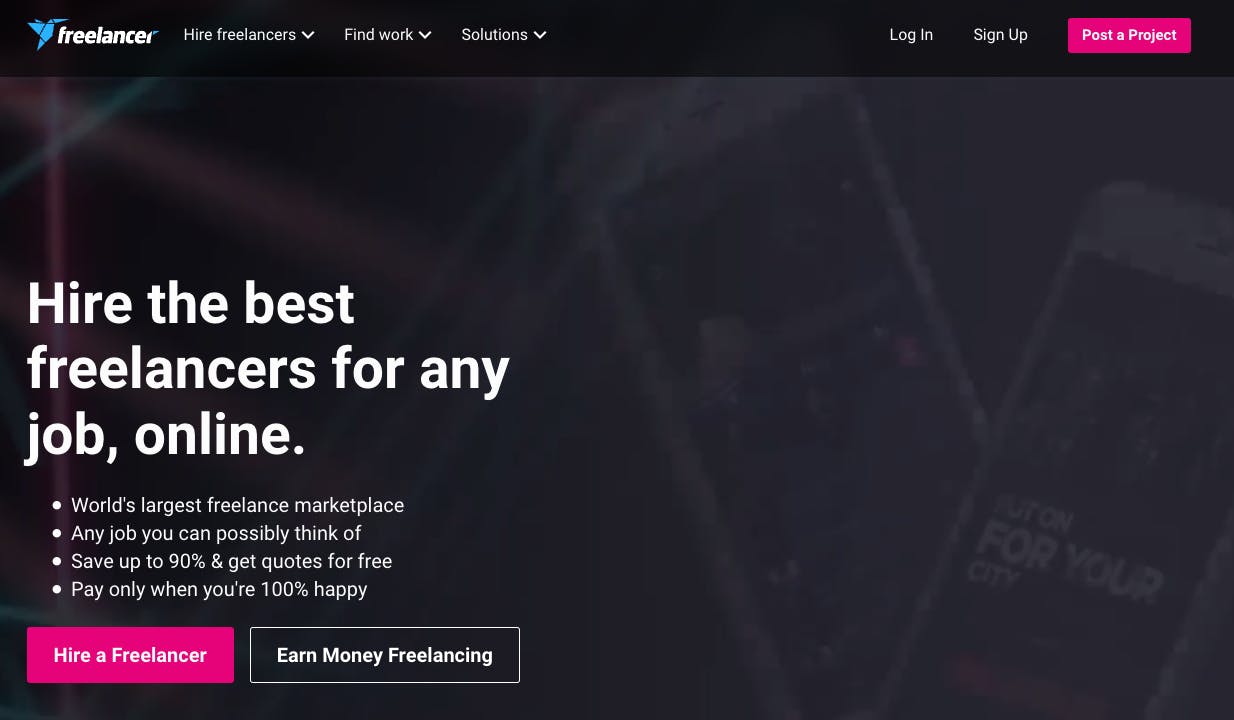
Toptal connects clients with top-tier freelancers, particularly in the tech, design, and finance sectors. It's known for its rigorous vetting process that ensures clients get access to highly skilled professionals. Toptal serves over 25,000 clients from 140+ countries.

FreeUp connects advertising, e-commerce, and marketing freelancers with digital companies. It offers over 250+ skill sets across various disciplines like copywriting, web development, digital writing, and more. Similarly to Toptal, FreeUp positions as a marketplace for top-quality freelancers, announcing they only feature the top 1% of applicants.

TaskRabbit is ideal for local freelance jobs. It connects clients with nearby "Taskers" for services like home repairs, cleaning, and moving. It's a great example of how freelance marketplaces can serve local, in-person needs. TaskRabbit has over 700,000 ongoing tasker-client relationships.
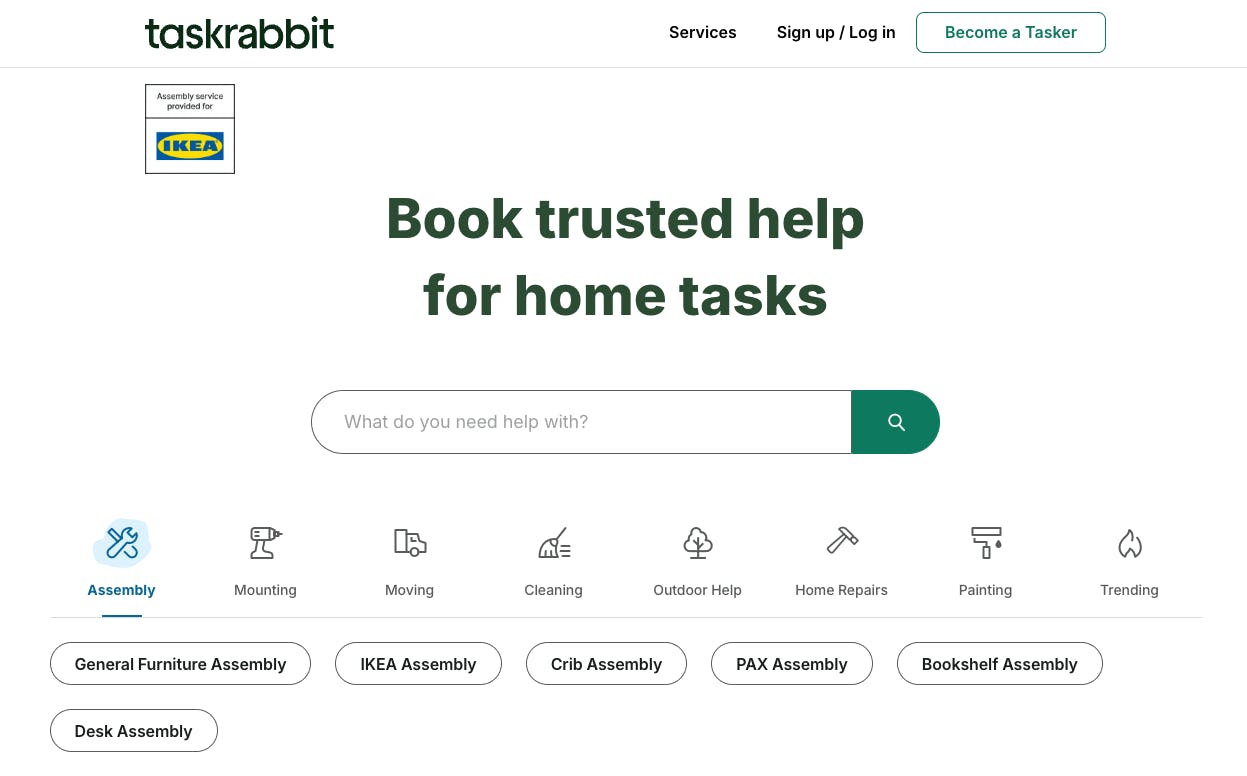
Freedomly is an example of a locally-focused freelance marketplace built on the Sharetribe marketplace solution. It focuses on connecting marketing, communication, and design professionals with clients specifically in the Finnish market. The local approach helps Freedomly compete against big, global players.
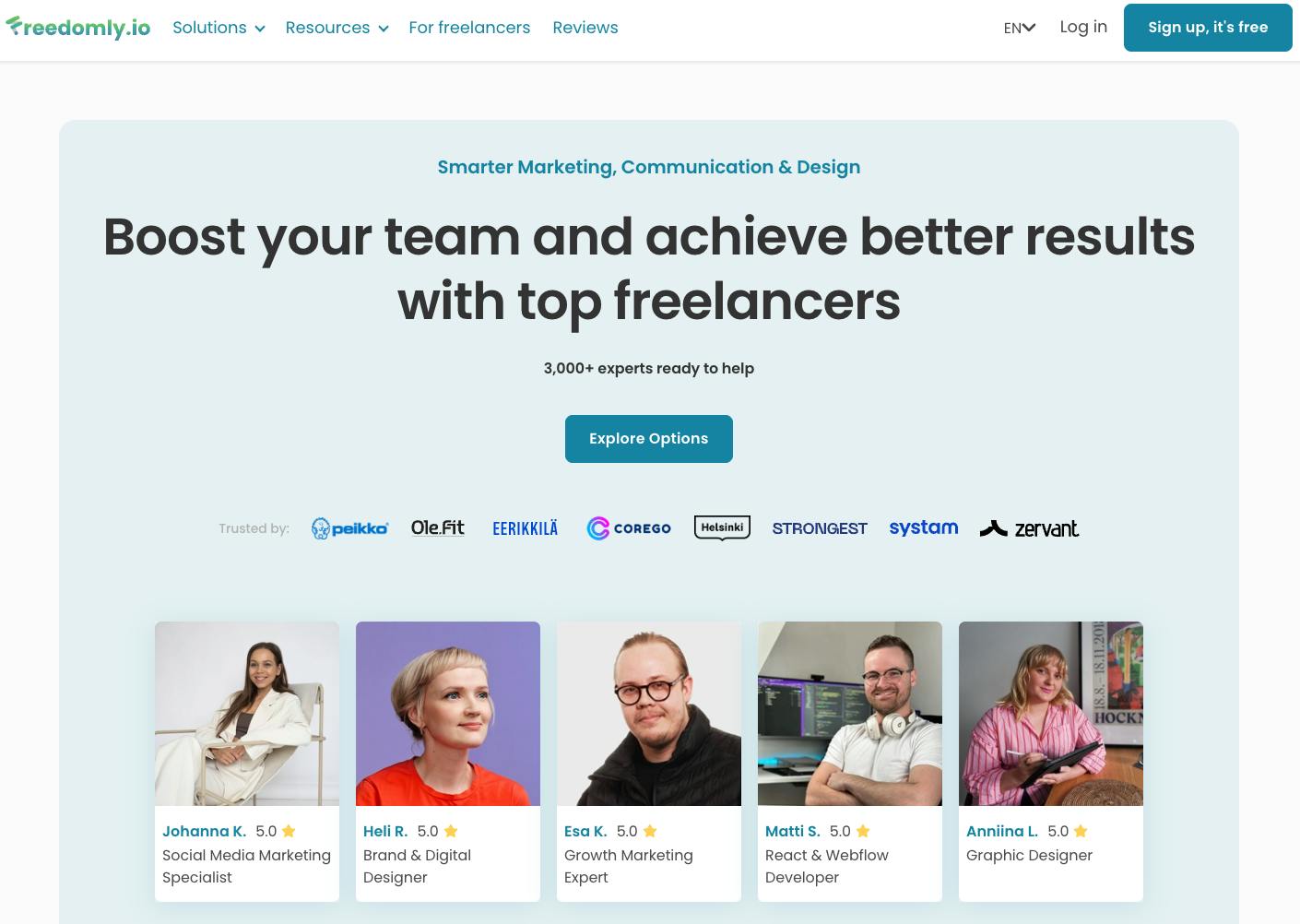
Designhill is a freelance marketplace focused on design jobs like logo, web, and graphic design. It offers both contest-style projects and direct hiring options. Designhill has over 330,904 designers from nearly 52 countries and has connected over a million clients.
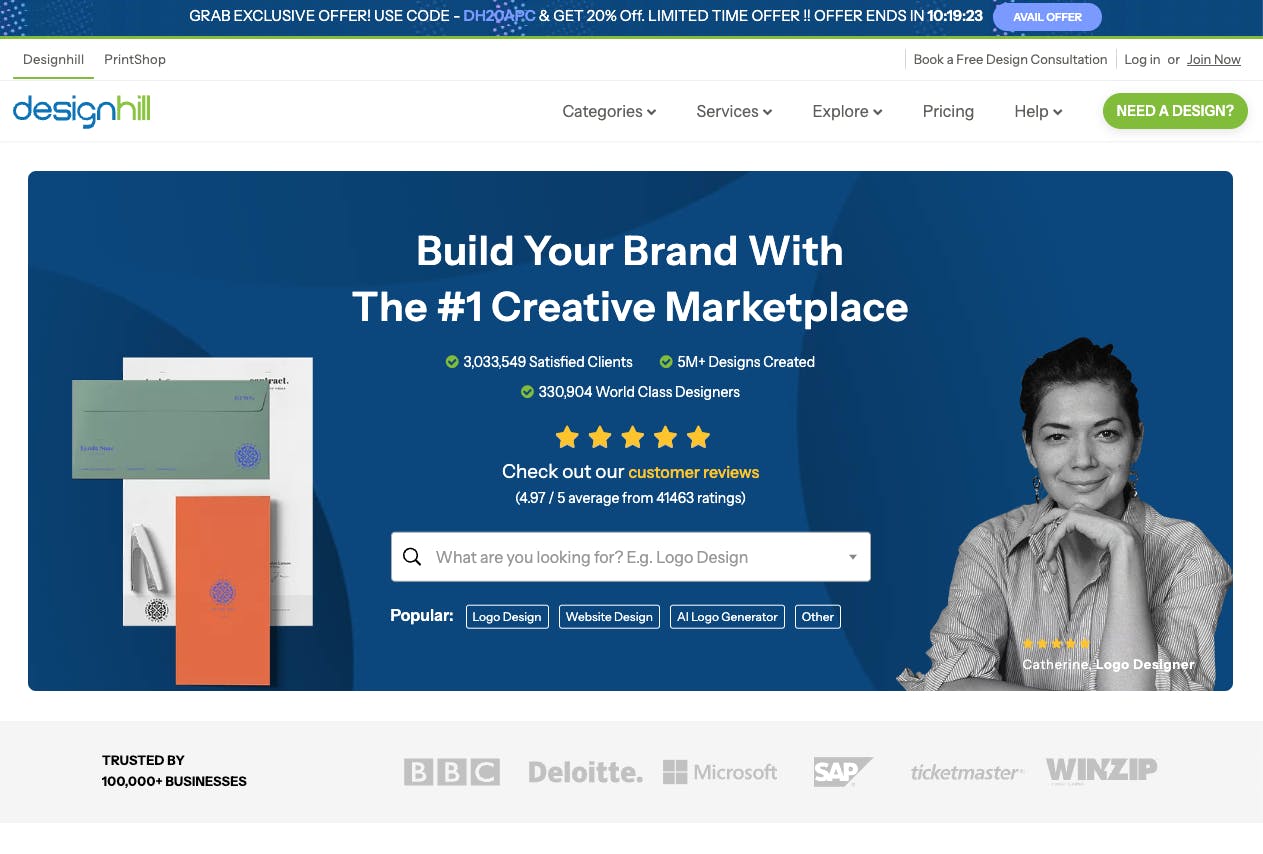
Mayple is a niche-focused, highly managed marketplace that connects businesses with top-tier marketing talent. It offers a rigorous vetting process that pre-screens each marketer and carefully matches them to projects based on their expertise. This guarantees that businesses find the right fit for their needs. Since its launch over five years ago, Mayple has grown to feature over 1,000 marketing experts and 600 customers.

The typical workflow of a freelance marketplace begins with registration, where freelancers and clients create accounts. Freelancers then typically build profiles to showcase their skills, experience, and portfolio, while clients might post project details, including requirements and budget.
The platform's matching system, often powered by search and matching algorithms, helps connect freelancers with suitable projects and clients with qualified freelancers. In most cases, the platform has some functionality to help the parties agree on the work terms and review each other after the work is completed. Most platforms also process the payment from the client to the freelancer and take a cut out of each transaction.
In summary, the key features of a freelance marketplace are:
- User signup and profiles, typically for both the freelancers and clients
- Listing creation, either for clients to advertise their projects or for freelancers to list their offerings.
- Search & matching system to help clients find suitable freelancers and vice versa.
- Communication tools like messaging apps.
- Payment processing, with an escrow system for security.
- Review and rating system for feedback
However, the exact feature requirements for a freelance marketplace depend a lot on whether the matching process is traditional or reverse. (More on these two types a bit later).
There are two primary types of freelance marketplaces: the traditional model and the reverse model. Let's explore each in detail and discuss how the choice of model impacts marketplace development and user base growth.
In the traditional freelance marketplace model, freelancers create detailed service listings, often referred to as "gigs," that highlight their unique value proposition. These gigs outline their offerings, pricing, delivery timeframes, and any additional options or upgrades.
Clients browse through these listings to compare services and make hiring decisions based on factors like price, reviews, and portfolio samples. Fiverr is a well-known example of this approach. If you're interested in the traditional model, check out our guide on how to build a website like Fiverr.
This model often works well for standardized or productized services, where the scope and deliverables can be clearly defined upfront. (For example, Fiverr famously started out as a platform where all the jobs cost $5.)
The reverse freelance marketplace model shifts the dynamic. Here, clients post job listings that outline their project requirements, budget, timeline, and any specific skills or experience they're seeking. Freelancers can then apply or submit proposals for the job.
Upwork and Freelancer.com are examples of platforms using this model. If you're interested in the reverse model, check out our guide on how to build a website like Freelancer.com.
This model works best for more complex or customized projects where the requirements may not be easily standardized. It gives clients more control over the hiring process and lets them compare multiple proposals before hiring.
The model you choose will significantly shape the development of your marketplace. Consider these key factors when deciding on the best approach:
- User experience: Do you want your clients searching for freelancers, or will freelancers bid on client projects? Each model requires a unique interface and user flow to facilitate these interactions.
- Freelance job type: Will your freelancers offer standardized pricing packages or allow for flexible, negotiable rates? Traditional models typically favor fixed pricing, while reverse models are often better suited for more flexible arrangements.
- Quality control: How will you ensure high-quality matches between freelancers and clients? Reverse models usually feature more detailed project requirements upfront, which can lead to better alignment between clients and freelancers.
- Marketing strategy: The model you choose will influence which side of the marketplace you should prioritize attracting first. For the reverse model, it’s often more effective to attract clients first, while traditional models may need freelancers to establish their service listings before clients are drawn in. Think about which side of your freelance marketplace idea is harder to get—that’s usually the side you should start with.
Some platforms adopt a hybrid approach that blends features from both models to cater to a wider audience. Ultimately, you should evaluate your marketplace’s structure and needs carefully before building your website.
The freelance market is rapidly expanding, with approximately 1.57 billion people in the global workforce now freelancing. According to Upwork Global Inc.’s 2023 Freelance Forward survey, 38% of the U.S. workforce—about 64 million Americans—engaged in freelance work, marking a 78% increase over the past decade.

In terms of economic impact, freelancers contributed $1.27 trillion to the U.S. economy in 2023 alone. The global online freelance platforms market was valued at $2.19 trillion in 2023 and is projected to grow to $5.63 trillion by 2031.
This enormous market has fueled the growth of major platforms like Upwork and Fiverr. However, new entrants can still differentiate themselves by focusing on specialization, quality, and offering additional services. This is especially relevant in B2B marketplaces, where users prioritize having their specific needs met over the overall size of the platform. They often appreciate marketplaces that narrow down the pool to the best candidates or job opportunities.
As a result, we are seeing the rise of highly curated, niche-focused marketplaces. For example, Toptal specializes in tech and design talents, while FreeUp connects e-commerce, marketing, and advertising freelancers with digital companies. Because these platforms focus on specific niches, they stand out from more generalist marketplaces and leave plenty of room for new players to enter with specialized offerings.
Interestingly, the barrier to entry for building a freelance marketplace has never been lower. Nowadays, you don’t need coding expertise or a team of developers working for weeks to set things up. There are no-code tools like Sharetribe that let you build a freelance marketplace from the ground up without writing a single line of code, and often within just a few days. This democratization of marketplace creation technology lets individuals with innovative ideas quickly bring their visions to life and test them in the market.
The process to build a successful freelance marketplace follows 10 steps:
- Identify a strong marketplace idea.
- Choose the right marketplace business model.
- Start with a focused scope.
- Pre-validate your marketplace idea.
- Build a marketplace platform, starting with an MVP (Minimum Viable Platform).
- Onboard your first clients.
- Launch your marketplace.
- Reach problem-solution fit.
- Reach product-market fit.
- Scale into new markets.
This is the process we’ve seen work time and time again as we’ve worked with hundreds of marketplace founders over more than a decade.
Next, we’ll discuss the ten steps and how they can help you build a successful freelance marketplace. For more information and useful resources, check out our complete guide on building an online marketplace.
The first step in building a freelance marketplace is identifying a solid idea. To do that, look at the problems freelancers and clients face on existing platforms and think about how you can make things easier for them. Your idea might come from your experience, what you see happening in the freelance community, or emerging trends.
For example, here’s how FreeUp identified their marketplace idea: Connor Gillivan and Nathan Hirsch, the founders of FreeUp, got frustrated with how much time they spent searching, vetting, and interviewing freelancers on big platforms. So, they created FreeUp—a marketplace that makes it easier for online business owners to find and hire vetted freelancers specifically in e-commerce, marketing, and advertising.
Alternatively, you can talk to freelancers and their clients directly. Ask them about their pain points and what they wish was easier. Forums could be a source of intel as well: for example, the subreddit for Upwork clients and freelancers is big and active.
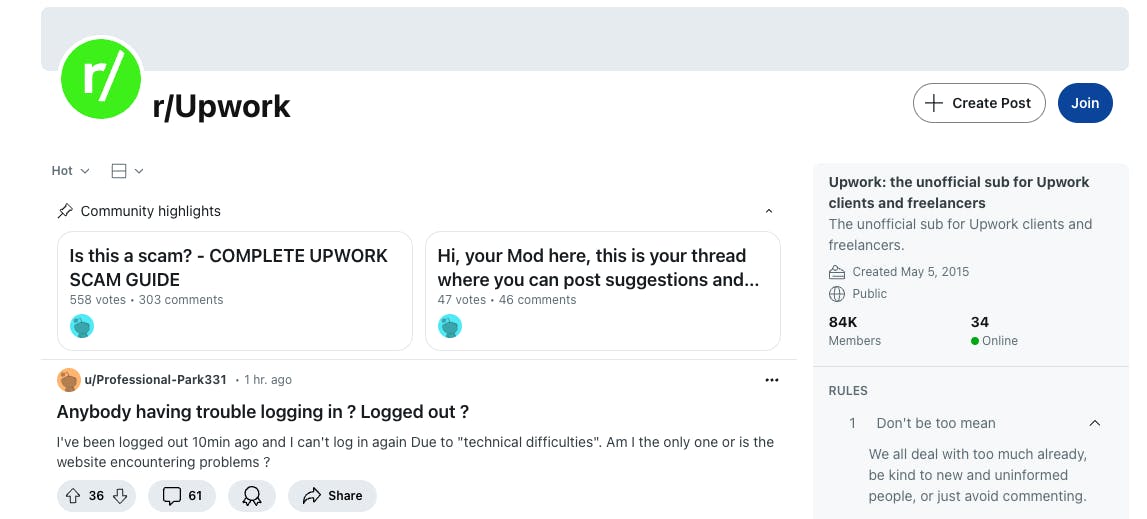
This research will help you uncover gaps in the market where current platforms fall short, whether it’s a more efficient way to match skills with projects or a system that streamlines payments and improves security.
Whichever idea you land on, it’s essential that your freelance marketplace:
- Solves a real problem for both clients and freelancers.
- Targets a large enough market to meet your business goals.
- Has a sufficient number of freelancers and clients within the chosen niche.
This is the stage where you figure out how your freelance marketplace will generate revenue. At Sharetribe, we researched the top 100 marketplaces in the world and found that most platforms use one or more of these six revenue models:
- Commission
- Subscription
- Listing fees
- Lead fees
- Freemium models
- Featured listings.
The commission-based model is the most common for freelance marketplaces. In this model, the platform charges a percentage of the total transaction value in commission. Most marketplaces have a fee for both sides: for example, Upwork, Guru, and Fiverr all charge both the freelancers and the clients a fee for a completed transaction on the platform.
The size of fees can differ greatly, and there’s room for differentiation here: for example, Toptal charges all of its fees from the clients, nothing from freelancers.
Also, some platforms combine two or more business models, such as lead fees or subscriptions, with the commission model. For instance, while Upwork primarily uses a commission model, it complements it with lead fees. Freelancers pay to get "Connects" that serve as a credit to submit proposals.
Similarly, Freelancer.com and Guru complement the commission model with lead fees. Freelancers are given limited free bids monthly and have the option to purchase more.
If you're considering the commission model, here are three important things to think about:
- Who will you charge? Will it be the freelancers or the clients, or both?
- How much will you charge? You'll need to decide what percentage of each transaction you'll take. (Here’s our guide to marketplace pricing.)
- How will you prevent users from avoiding your platform's payment system? Ensuring that all transactions go through your platform is essential for consistent revenue. (Here’s our guide to avoiding platform leakage.)
While early freelance marketplaces like Upwork and Freelancer.com succeeded with a generalist approach, the market has changed significantly since their launch. Today, new entrants need a more focused strategy to stand out.
Early generalist platforms benefited from less competition across online service niches. Additionally, venture investors were more willing to fund based on the size of the total market rather than demanding early traction. Now, however, investors prioritize real user engagement and growth over just a large potential market.
Because of this shift, it’s critically important for new freelance marketplace startups to focus their limited resources on a specific niche. Replicating the broad, generalist approach of major platforms like Upwork is both capital-intensive and highly competitive, making it difficult for smaller, newer players.
Focusing your scope could mean:
- Targeting a specific industry or skill set for your marketplace.
- Concentrating on a particular geographic region.
- Solving a specific problem within the freelance ecosystem.
Starting with a niche doesn’t limit your growth potential. In fact, once you’ve gained traction and built a solid reputation in your initial focus area, you can gradually expand into related skills or industries or continue to add more geographic locations. This approach allows you to grow sustainably while maintaining a strong foundation.
Before investing significant time and resources into building your freelance marketplace, it’s crucial to pre-validate your idea. Pre-validating your marketplace idea helps ensure the problem you want to solve truly exists and that there’s real market demand for your platform.
Here are some steps to pre-validate your idea:
- Talk directly to your target audience, both in person and online. Ask them if they’re experiencing the problem you’ve identified and how they’re currently solving it. Then, pitch a prototype of your solution and gather their feedback.
- Adapt based on feedback. If what you hear doesn’t align with your assumptions, adjust your approach and validate again. The goal is to continuously refine your idea based on real-world input.
When it comes to specific questions, open-ended ones tend to yield the best insights. Some useful questions include:
- How do you currently find freelance marketplaces? Is it easy to find jobs or clients?
- How do you vet the competence of clients or freelancers?
- Could you handle more jobs or clients than you currently have?
- How do your clients typically find you?
The goal of pre-validation isn’t to guarantee success but to gather enough evidence to justify moving forward. Be ready to iterate on your concept based on the feedback you receive—it’s all part of the process.
A Minimum Viable Platform (MVP) is a version of your marketplace that includes just enough features to attract early adopters and validate your core value proposition. The point is to get your idea out into the world as early as possible to start learning from real users.
At the very beginning, your solution could even be as simple as a spreadsheet and lots of manual work to connect the two sides. This helps you get to the market fast, avoid unnecessary development work, and learn about your audience.
For example, when Charles Armitage, co-founder of the healthcare staffing marketplace Florence started out, he spent months and a lot of money on a website that didn’t even have the basic features they needed. In the end, he had to roll back to using just a Google sheet.
Sophie Adelman, co-founder of WhiteHat (rebranded as Multiverse) and ex-Hired, also talks about the advantages of starting simple:
“If you build a tech product before you understand what you need, you end up building something doesn't actually work. So, I actually think that those organizations that don't start by using spreadsheets and whiteboards are missing a trick, because you learn a huge amount, and it allows you to, to know when pain points are in your process.”
Another great option for your MVP is Sharetribe. Its no-code marketplace builder could get the first version of your freelance marketplace live in a matter of days. Our solution also has the benefit that once you’ve validated your idea and are ready to develop your platform further, you can easily add custom-developed designs, features, and functionalities on top of your MVP.
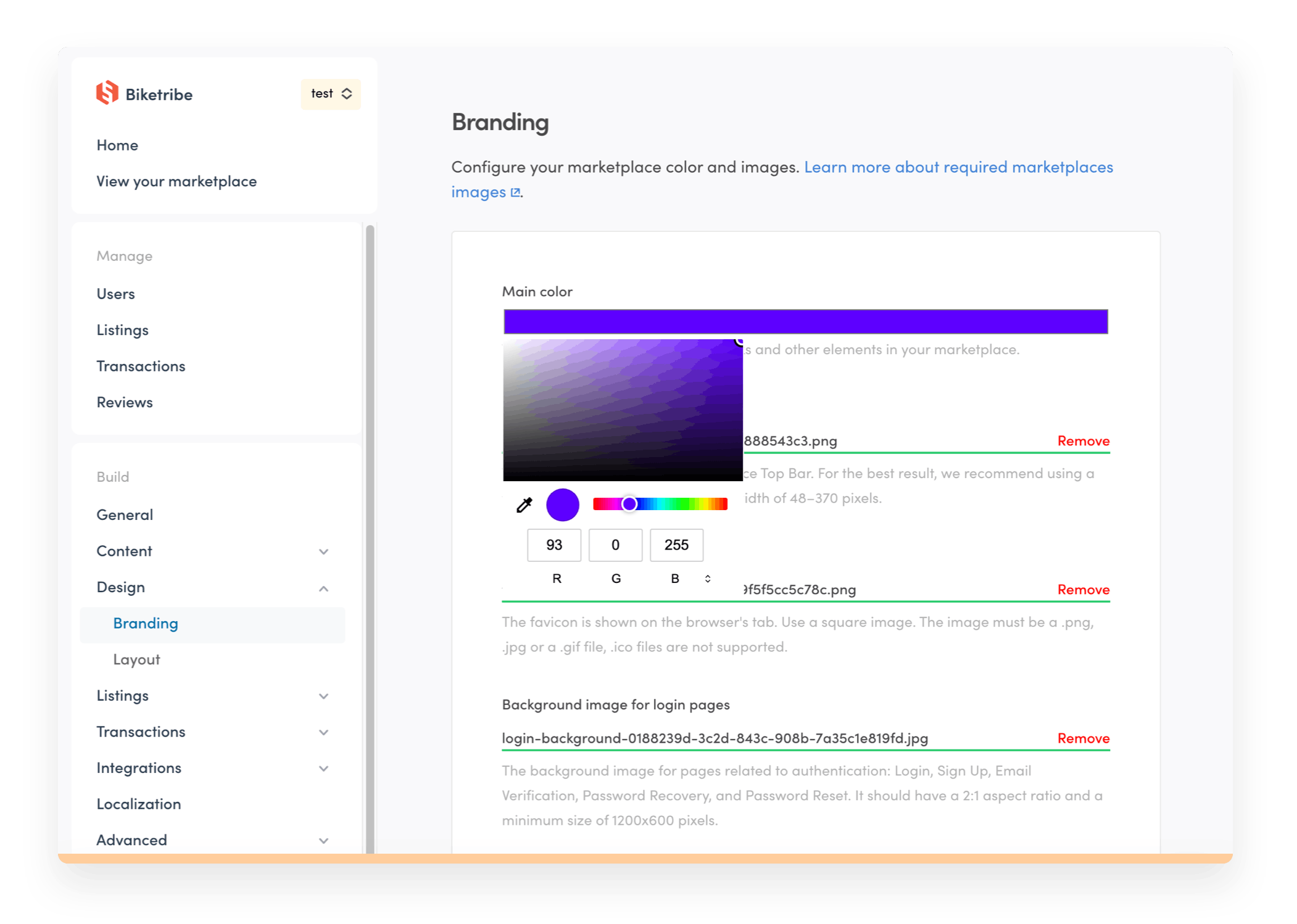
Most marketplaces face the classic chicken-and-egg problem: should you focus on attracting clients or freelancers first? You need freelancers to fulfill clients’ jobs, but you also need the promise of clients to attract freelancers.
Most successful marketplaces solve this by focusing on the supply side first. The thinking is that the supply side is easier to attract even when there’s no demand yet, whereas the demand needs to see high-quality supply to get interested in the marketplace.
In the context of freelance marketplaces, freelancers are often seen as the supply and clients as the demand.
So, how do you find these first freelancers? Here are a few places you could look:
- Online groups and communities: Engage in Facebook groups, LinkedIn communities, Reddit forums, or niche online platforms where freelancers in your target industry gather.
- Offline groups and communities: Attend local meet-ups, participate in industry-specific conferences, or host events to connect with potential freelancers in person.
- Paid search engine ads: Use targeted ads with a small budget to reach freelancers who may be actively searching for work opportunities.
- Cold-calling and direct outreach: Though more time-intensive, reaching out directly to freelancers through email or phone can give you a personal touch that attracts high-quality talent.
Once you’ve identified potential freelancers, use the following tactics to get them to sign up:
- Clearly communicate your unique value proposition—explain how your platform helps them get more work and serves them better than existing solutions.
- Communicate how you’re planning to find and onboard clients, highlighting the potential for demand.
- Offer exclusivity: communicate that your marketplace only lets in the top tier of freelancers.
- Offer them better tools to manage and bill for their work.
- Offer discounts or other financial incentives to be an early adopter.
If you can provide an exceptional experience for your first few freelancers, they’re likely to refer others to your platform. At this stage, focus on quality over quantity. As you onboard freelancers, it’s crucial to pre-vet them for quality, skills, and identity. You can implement vetting processes like skill tests, ID verification, or portfolio reviews to ensure you’re only accepting the best talent. This helps ensure that when you bring in your first clients, both sides will have a smooth experience collaborating through your platform.
Once your initial freelance base is in place, you can open your marketplace to the clients. However, remember that this first launch doesn’t have to be a big, flashy event—what you need is just enough demand to satisfy your initial supply and ensure that transaction start happening. This helps you test your platform, iron out any issues, and build a loyal user base.
Here are some effective strategies for finding clients::
- Leverage your network: Reach out to personal and professional connections who might benefit from your platform.
- Targeted outreach: Engage with online communities, social media groups, or forums where your ideal clients are active.
- Run online ads: Use paid advertising to target clients who are most likely to need your services.
- Introduce referral programs to incentivize word-of-mouth growth.
For instance, in our interview with FreeUp, founder Connor Gillivan shared that their first clients were so satisfied that they began referring colleagues and fellow business owners.
To build on this momentum, FreeUp introduced a referral program, paying $0.50 for every hour billed to a user who joined through a referral. This strategy became one of their most effective growth channels, helping them gain visibility in key media outlets.
Finally, don’t forget to actively monitor and engage with your early users. Offer excellent support and be responsive to their needs. This feedback loop can help you refine your marketplace in its early stages, leading to a stronger launch overall.
Reaching problem-solution fit means you've successfully identified a real problem in the market and created a solution that effectively meets the needs of both clients and freelancers. At this stage, your platform should be facilitating consistent transactions between supply (freelancers) and demand (clients) and generating revenue from those transactions.
It’s important to note that reaching problem-solution fit doesn’t necessarily mean your marketplace is profitable yet, but there should be promising signs that you’re on the right track.
Here’s what problem-solution fit looks like:
- You’re consistently facilitating transactions between freelancers and clients.
- You’re generating revenue from those transactions, even if it's not yet at a large scale.
If you don’t see signs of problem-solution fit, it’s time to reevaluate and iterate on your approach. The best way to do this is by asking your users for feedback. Consider the following:
- Do users clearly understand your platform's purpose? If not, you may need to refine how you communicate your value proposition.
- Are you attracting freelancers with the right skill sets that match what clients are looking for? Or, are there enough job opportunities for freelancers?
- If you have enough users but they’re struggling to find suitable matches, it may be a sign to revisit your matching process or algorithm.

At this stage, the focus should be refinement rather than rapid growth. Scaling too early can expose flaws in your business model, making them harder to fix later. Instead, focus on improving your core offering based on user feedback, ensuring that your marketplace is truly solving the right problems for your target audience.
Achieving product-market fit means your freelance marketplace meets strong market demand, solving a real problem while showing potential for scalable growth and long-term success. This is the stage where your platform starts to resonate with users, and the foundations for growth are in place.
Key indicators of product-market fit include:
- Supply and demand liquidity: Clients can consistently find the services they need, and freelancers are successfully converting proposals into bookings.
- Favorable unit economics: Your customer acquisition costs are lower than your customer lifetime value.
- Optimized matchmaking and seamless transactions: The process of connecting clients and freelancers is efficient and smooth.
- Proven retention and repeat usage: Users are coming back and engaging with your platform regularly.
Among these, liquidity is the most important metric. Liquidity means both sides—clients and freelancers—can easily find what they’re looking for, leading to successful transactions.
Here are a few strategies to boost your marketplace's liquidity:
- Direct sales: Actively reach out to potential clients and freelancers to build both sides of your marketplace.
- Marketplace SEO: Optimize your platform for search engines to attract organic traffic.
- Viral marketing: Encourage word-of-mouth referrals and social sharing to drive user growth.
- Network effects: As more users join, your platform becomes more valuable to everyone, creating a natural boost to liquidity.
If your goal is to build a major global freelance marketplace, this is the stage to develop a solid playbook. A large-scale marketplace will likely require external marketplace funding to support expansion.
Recall that investors are now more focused on profitability than just growth potential. So, to attract investment, you’ll need to demonstrate that your platform has achieved product-market fit and that you have a clear, replicable strategy for entering new markets.
Once you've achieved product-market fit, you can scale your freelance marketplace and capture a larger market share. Apply the playbook you've created and replicate the strategy to enter new markets.
There are three primary ways to scale:
- Adding a new location (e.g., a graphic designers' freelance marketplace initially serving the US market expands to serve users in the UK.)
- Introducing a new category (A platform initially focused on web development services adds a new category for technical writing.)
- Targeting a new customer segment (A freelance marketplace initially for small businesses and startups begins targeting enterprise-level clients.)
However, when scaling into a new market, it’s crucial to follow these steps:
- Scale one market at a time: Avoid spreading yourself too thin by focusing on one market before moving to the next.
- Reach product-market fit in each market: Ensure your platform meets the needs of users in the new market before expanding further.
- Create a playbook of effective strategies: Document the approaches that worked in your initial market and adjust them as needed for new ones.
- Repeat the process until you’ve achieved your business goals.
Also, before choosing your next market, conduct thorough research to understand how it differs from your initial one. Evaluate factors such as local competition, regulatory requirements, and cultural nuances that may impact the adoption of your platform. This careful analysis will help you make informed decisions and ensure a smoother expansion.
The freelance economy is booming, offering countless opportunities for platforms that can meet specific needs or serve underserved niches. However, building a successful freelance marketplace requires thoughtful planning, execution, and continuous iteration.
Here are the key steps to remember:
- Identify a strong idea that addresses real problems for both freelancers and clients.
- Start with a niche focus to differentiate your platform from larger, established competitors.
- Build and launch your MVP using no-code tools to get up and running quickly.
- Validate your idea and gather feedback at every stage—from launch to scaling.
While the process may seem challenging, modern tools have made it easier than ever to start. With no-code solutions like Sharetribe, you can launch your freelance marketplace in just a few days, allowing you to test your ideas and iterate based on real-world feedback.
Ultimately, the most important step is to start today. The sooner you begin, the sooner you'll gather valuable insights to refine your marketplace and set yourself up for growth.
Start your 14-day free trial
Create a marketplace today!
- Launch quickly, without coding
- Extend infinitely
- Scale to any size
No credit card required
